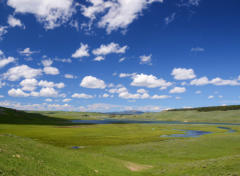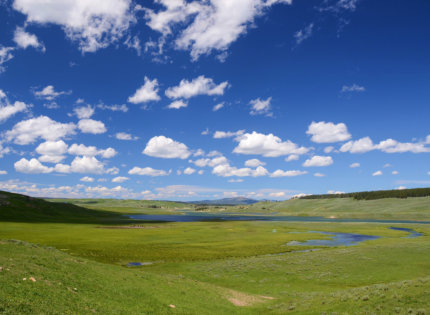
HISTORY ONLINE 24/7/365
COLD WAR
The Cold War in U. S. History 2
Following World War II, the United States emerges as the most powerful nation, largely untouched as other nations face recovery from the damages of years of war, and the only nation with nuclear weapons. This unit deals with post-war America from a foreign policy standpoint, covering the rebuilding of friends and former enemies, the emergence and response to nuclear threats, and America’s role as a global super-power militarily, politically, and economically.Resources:
Cold War Study Guide! Click here for your study guide! CNN-The Cold War -- The web page for CNN's outstanding and comprehensive 24 part documentary from 1998. The Berlin Airlift -- Newseum page The Berlin Airlift (from the German point of view!) Korean War: Korean War page from the BBC Berlin Wall: Berlin Wall page from the Berlin website (in English) Berlin Wall page from the BBC with several videos from the blockade to reunification! Berlin Wall Archive from the BBC, with radio and TV reports History Extra - Berlin Wall page Whatever happened to the Wall from the Guardian Listen to Tunnel 29, a podcast about digging tunnels under the Wall History Extra - Remembering the Wall in pictures 30 years later Dancing at the Berlin Wall --Revisiting the fall 30 years later! How Berlin is celebrating the 30th anniversary Visit Berlin --Anniversary webpageClick Here to go to Cold War Videos:
Watch review lessons from VA TV Classroom and WHRO on emediaVA:
CLICK HERE to watch a review on Post-War Rebuilding and the Causes of the Cold War CLICK HERE to watch a review on the main events of the Cold WarSOL Info:
The Allied victory in World War II led to the emergence of the United States and the Soviet Union as global superpowers. The United States’ involvement in World War II reshaped America’s role in world affairs. Much of Europe was in ruins following World War II. Soviet forces occupied most of Eastern and Central Europe and the eastern portion of Germany. The United States believed it was in its best interest to help rebuild Europe and prevent political and economic instability. Rebuilding efforts • The United States instituted George C. Marshall’s plan to rebuild Europe (the Marshall Plan), which provided massive financial aid to rebuild European economies and prevent the spread of communism. • Germany was partitioned into East and West Germany. West Germany became democratic and resumed self-government after a few years of American, British, and French occupation. East Germany remained under the domination of the Soviet Union and did not adopt democratic institutions. • Following its defeat, Japan was occupied by American forces. It soon adopted a democratic form of government, resumed self-government, and became a strong ally of the United States. Establishment of the United Nations • The United Nations was formed near the end of World War II to create a body for the nations of the world to try to prevent future global wars. The United States and the Soviet Union emerged from World War II as world powers, triggering a rivalry over ideology and national security. The Cold War was the central organizing principle in global affairs for over 40 years. Term to know • Cold War: The state of tension without actual fighting between the United States and the Soviet Union, which divided the world into two camps Origins of the Cold War • Differences in goals and ideologies between the United States and the Soviet Union (the two superpowers); the United States was democratic and capitalist while the Soviet Union was dictatorial and communist • The Soviet Union’s domination over Eastern European countries (Iron Curtain) • American policy of containment (to stop the spread of communism) • North Atlantic Treaty Organization (NATO) vs. Warsaw Pact (defense alliances) Major conflicts in the post-World War II era that reflected Cold War tensions • South Korea and the United States resisted Chinese and North Korean aggression. The conflict ended in a stalemate. • Disagreements arose between the United States and the Soviet Union over the status of Berlin, eventually leading to the construction of the Berlin Wall. • The Cuban Missile Crisis occurred when the Soviet Union placed missiles in Cuba. The Soviets removed the missiles in response to a United States blockade of Cuba, and the United States removed missiles from Turkey. • The United States intervened to stop the spread of communism into South Vietnam (domino theory). Americans were divided over whether the United States should be involved militarily in Vietnam. The conflict ended in a cease-fire agreement in which United States troops withdrew. • The Space Race between the United States and the Soviet Union was a contest to gain technological superiority (e.g., Sputnik, landing on the moon). • The Arms Race was the stockpiling of nuclear weapons as a deterrent to nuclear war. Collapse of communism in Europe • Breakup of the Soviet Union into independent countries • Destruction of the Berlin Wall New challenges • Role of United States military intervention • Environmental challenges • Global issues, including trade, jobs, diseases, energy • Rise/emergence of China as a global economic and military powerCold War Video:
While it is not in the public domian, two episodes of the Twilight Zone original anthology series are also recommended. The series is widely available for sale, available for checkout at the Fluvanna County Library, and at this writing, streams on Netflix and Amazon Prime if you subscribe to those services. Look for Season 1, Episode 8, Time Enough at Last, and Season 3, Episode 3, The ShelterU.S. Mapping Games:
Click to start here with a simple tutorial Drag and Drop by Region Drag and Drop Click on the State Drag and Drop (Harder)

PHYSICAL REGIONS
Looking for the physical regions
of North America from the
Virgina Standards of Learning
for U. S. History I?




































HISTORY ONLINE 24/7/365
mrbower.com
COLD WAR
The Cold War in U. S. History 2
Following World War II, the United States emerges as the most powerful nation, largely untouched as other nations face recovery from the damages of years of war, and the only nation with nuclear weapons. This unit deals with post-war America from a foreign policy standpoint, covering the rebuilding of friends and former enemies, the emergence and response to nuclear threats, and America’s role as a global super-power militarily, politically, and economically.Resources:
Cold War Study Guide! Click here for your study guide! CNN-The Cold War -- The web page for CNN's outstanding and comprehensive 24 part documentary from 1998. The Berlin Airlift -- Newseum page The Berlin Airlift (from the German point of view!) Korean War: Korean War page from the BBC Berlin Wall: Berlin Wall page from the Berlin website (in English) Berlin Wall page from the BBC with several videos from the blockade to reunification! Berlin Wall Archive from the BBC, with radio and TV reports History Extra - Berlin Wall page Whatever happened to the Wall from the Guardian Listen to Tunnel 29, a podcast about digging tunnels under the Wall History Extra - Remembering the Wall in pictures 30 years later Dancing at the Berlin Wall --Revisiting the fall 30 years later! How Berlin is celebrating the 30th anniversary Visit Berlin --Anniversary webpageClick Here to go to Cold War Videos:
Watch review lessons from VA TV
Classroom and WHRO on emediaVA:
CLICK HERE to watch a review on Post-War Rebuilding and the Causes of the Cold War CLICK HERE to watch a review on the main events of the Cold WarSOL Info:
The Allied victory in World War II led to the emergence of the United States and the Soviet Union as global superpowers. The United States’ involvement in World War II reshaped America’s role in world affairs. Much of Europe was in ruins following World War II. Soviet forces occupied most of Eastern and Central Europe and the eastern portion of Germany. The United States believed it was in its best interest to help rebuild Europe and prevent political and economic instability. Rebuilding efforts • The United States instituted George C. Marshall’s plan to rebuild Europe (the Marshall Plan), which provided massive financial aid to rebuild European economies and prevent the spread of communism. • Germany was partitioned into East and West Germany. West Germany became democratic and resumed self-government after a few years of American, British, and French occupation. East Germany remained under the domination of the Soviet Union and did not adopt democratic institutions. • Following its defeat, Japan was occupied by American forces. It soon adopted a democratic form of government, resumed self-government, and became a strong ally of the United States. Establishment of the United Nations • The United Nations was formed near the end of World War II to create a body for the nations of the world to try to prevent future global wars. The United States and the Soviet Union emerged from World War II as world powers, triggering a rivalry over ideology and national security. The Cold War was the central organizing principle in global affairs for over 40 years. Term to know • Cold War: The state of tension without actual fighting between the United States and the Soviet Union, which divided the world into two camps Origins of the Cold War • Differences in goals and ideologies between the United States and the Soviet Union (the two superpowers); the United States was democratic and capitalist while the Soviet Union was dictatorial and communist • The Soviet Union’s domination over Eastern European countries (Iron Curtain) • American policy of containment (to stop the spread of communism) • North Atlantic Treaty Organization (NATO) vs. Warsaw Pact (defense alliances) Major conflicts in the post-World War II era that reflected Cold War tensions • South Korea and the United States resisted Chinese and North Korean aggression. The conflict ended in a stalemate. • Disagreements arose between the United States and the Soviet Union over the status of Berlin, eventually leading to the construction of the Berlin Wall. • The Cuban Missile Crisis occurred when the Soviet Union placed missiles in Cuba. The Soviets removed the missiles in response to a United States blockade of Cuba, and the United States removed missiles from Turkey. • The United States intervened to stop the spread of communism into South Vietnam (domino theory). Americans were divided over whether the United States should be involved militarily in Vietnam. The conflict ended in a cease-fire agreement in which United States troops withdrew. • The Space Race between the United States and the Soviet Union was a contest to gain technological superiority (e.g., Sputnik, landing on the moon). • The Arms Race was the stockpiling of nuclear weapons as a deterrent to nuclear war. Collapse of communism in Europe • Breakup of the Soviet Union into independent countries • Destruction of the Berlin Wall New challenges • Role of United States military intervention • Environmental challenges • Global issues, including trade, jobs, diseases, energy • Rise/emergence of China as a global economic and military powerCold War Video:
While it is not in the public domian, two episodes of the Twilight Zone original anthology series are also recommended. The series is widely available for sale, available for checkout at the Fluvanna County Library, and at this writing, streams on Netflix and Amazon Prime if you subscribe to those services. Look for Season 1, Episode 8, Time Enough at Last, and Season 3, Episode 3, The ShelterU.S. Mapping Games:
Click to start here with a simple tutorial Drag and Drop by Region Drag and Drop Click on the State Drag and Drop (Harder)

PHYSICAL REGIONS
Looking for the physical regions of
North America from the Virgina
Standards of Learning for U. S.
History I?



































































